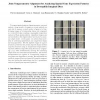47 search results - page 2 / 10 » Shape Alignment by Learning a Landmark-PDM Coupled Model |
CVPR
2005
IEEE
14 years 9 months ago
2005
IEEE
To compare spatial patterns of gene expression, one must analyze a large number of images as current methods are only able to measure a small number of genes at a time. Bringing i...
ICRA
2006
IEEE
14 years 1 months ago
2006
IEEE
— Mobile robots do not adequately represent the objects in their environment; this weakness hinders a robot’s ability to utilize past experience. In this paper, we describe a s...
ACL
2010
13 years 5 months ago
2010
We present an approach to multilingual grammar induction that exploits a phylogeny-structured model of parameter drift. Our method does not require any translated texts or token-l...
ICIP
2001
IEEE
14 years 9 months ago
2001
IEEE
In this paper we address the problem of registering 3D scattered data by the mean of a statistical shape model. This model is built from a training set on which a principal compon...
CVPR
2009
IEEE
15 years 2 months ago
2009
IEEE
A Bayesian marked point process (MPP) model is developed
to detect and count people in crowded scenes. The
model couples a spatial stochastic process governing number
and placem...

